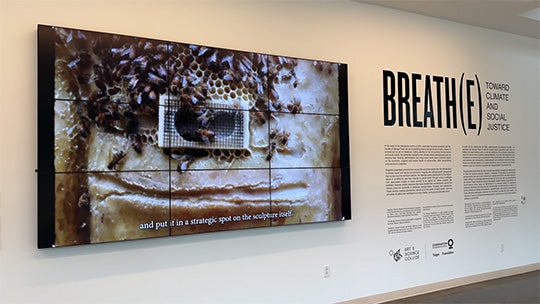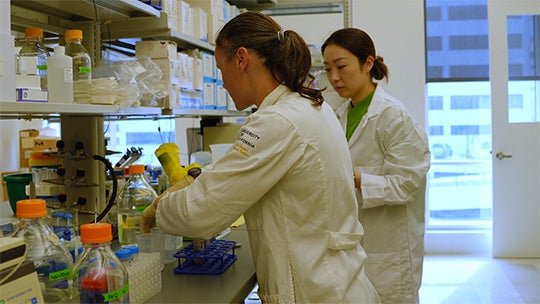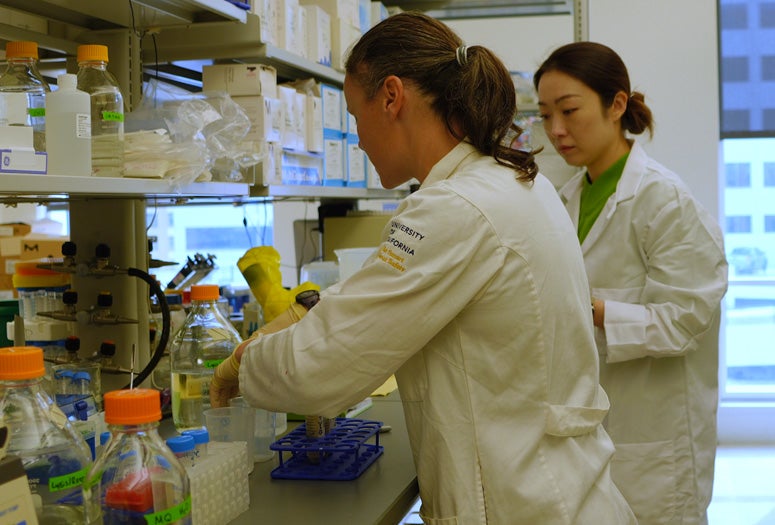A new installation at Rice University’s Moody Center for the Arts merges biosciences and art in an experiment with an uncertain outcome. The Moody commissioned artist Xin Liu in collaboration with researcher Erika Erickson to create a new work for the exhibition “Breath(e): Toward Climate and Social Justice” titled “The Permanent and the Insatiable” on view at the Moody until May 10.
The sculpture made from polyethylene terephthalate (PET) plastics represents the Houston skyline and Rice’s campus. Throughout the duration of the exhibition, the piece will be submerged in liquid enzymes designed to break it down, mimicking the natural process of plastic degradation. The result is a contest between engineered durability and biological intervention.

Liu, a former artist-in-residence at Rice’s Houston Asian American Archive, developed the concept after collaborating with scientists to send plastic-degrading bacteria to the International Space Station in 2018.
“In material science, we’re constantly creating materials that are indestructible,” Liu said. “They have super performance and are fire resistant and chemical resistant. At the same time in biosciences, we’re trying to engineer super organisms to eat exactly that material. We’re going to either end up with tons of these materials that can never be destroyed, or maybe one day we’re going to end up with a world that is consumed by some kind of super organisms.”
The sculpture’s enzyme is being produced in George Phillips’ lab in Rice’s BioScience Research Collaborative, where Liu has worked closely with Erickson.
“We started brainstorming about what might be possible, and then slowly this opportunity to work here, find lab space and try to accomplish the goals of the project came together,” Erickson said.

Erickson explained that the bacteria-produced enzyme used in the installation is a hydrolase, a type of enzyme that breaks down PET plastic by severing its chemical bonds.
“Plastics are a polymer, which is just a repeating chain of similar compounds, so the enzyme is able to break those down into their starting components,” Erickson said. “The reason that this is exciting is that there’s the potential for this to be a way to do a better job of recycling than is currently available.”
Phillips, professor and associate chair of biosciences and associate dean of research, has worked extensively with enzymes that degrade polymers and said Liu’s installation could illustrate the potential of biological solutions for plastic waste.
“These complex polymers are pretty hard to digest, but nature has done experiments over billions of years to figure out how to eat almost anything,” Phillips said. “If the enzyme is active on this particular plastic, which we think it will be, the bacteria and the enzyme will win. It’s just a matter of how fast.”

While the technology remains a long way from widespread implementation, Erickson noted that researchers are exploring similar biological approaches to address plastic waste.
“To get there, we use this lab space to produce all of the bacteria and then open those bacteria to get the enzyme that they produce out, exploiting their natural life cycles to do what we want for this purpose,” Erickson said.
Phillips said he sees the installation as a perfect example of cross-disciplinary research in action.
“I was very eager to have the lab be used to help Xin Liu and to have some kind of collaboration with the humanities and the arts, which I think is fun when you can branch out at a university,” Phillips said. “Universities shouldn’t operate in silos. I mean, we’re all humans. We’re all in this together. And I think when we share ideas and technologies, the whole becomes more than the sum of the parts.”

Visitors to the Moody will witness a real-time battle between material resilience and enzymatic breakdown, raising questions about sustainability, human intervention and the future of waste management.
“‘Breath(e)’ is an exhibition about climate change and social justice,” said Alison Weaver, the Suzanne Deal Booth Executive Director of the Moody. “These pieces explore the ways our changing environment — through fires, floods, rising temperatures and different climate events — have an impact on communities and their social, economic and mental health,”
Originally organized by the Hammer Museum in Los Angeles, the exhibition has been adapted for Houston to highlight the specific environmental concerns of the Gulf Coast, including the commission of Liu’s work.
“It’s such a privilege to be able to work here,” Liu said. “I have to admit all the resources professor George Phillips has been able to lend us, allowing us to use a facility, is just a dream come true.”

